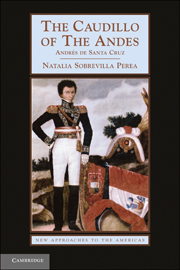Book contents
- Frontmatter
- Contents
- List of Maps and Illustrations
- Timeline for Santa Cruz
- Acknowledgments
- Introduction
- 1 Early Years at the Twilight of the Colonial Period
- 2 Great Marshall of Zepita
- 3 The Creation of Bolivia
- 4 The Genesis of the Peru-Bolivia Confederation
- 5 The Rise and Fall of the Peru-Bolivia Confederation
- 6 Defeat and Exile
- Epilogue: The Long-Term Consequences of the Fall of the Confederation
- Bibliography
- Index
6 - Defeat and Exile
Published online by Cambridge University Press: 05 June 2012
- Frontmatter
- Contents
- List of Maps and Illustrations
- Timeline for Santa Cruz
- Acknowledgments
- Introduction
- 1 Early Years at the Twilight of the Colonial Period
- 2 Great Marshall of Zepita
- 3 The Creation of Bolivia
- 4 The Genesis of the Peru-Bolivia Confederation
- 5 The Rise and Fall of the Peru-Bolivia Confederation
- 6 Defeat and Exile
- Epilogue: The Long-Term Consequences of the Fall of the Confederation
- Bibliography
- Index
Summary
The Confederate wars that raged between 1836 and 1839 mirrored, in many ways, the wars of independence. The close relationship between the south of Peru and the north of Bolivia remained the driving force for the union and was an extremely difficult area to penetrate either from the coast or from the south. In the 1830s – just as they had done two decades earlier – the men from the southern plains of what had become Argentina made an effort to reach these high valleys, and those attempting to do so by sea tried to take the coast of Arequipa. Also as before neither of these strategies was successful. The natural barriers – the deserts and high mountains – made access close to impossible, and the general support for the cause among the local populations made the core of the Confederation impregnable.
This chapter explores how once again, replaying a conflict already experienced, success was found by attacking Lima and establishing a strong military force in the northern Andes. Lima was an easy target and could not be defended, whereas the northern Andes provided a peaceful and relatively wealthy place from which to prepare for the campaign. This chapter examines how, even though the Confederate army was the better prepared, it was ultimately defeated. Santa Cruz had endeavored to retain its loyalty by paying his troops fairly. He was good at providing his men with food and clothing and he had developed a dedicated following among troops and officers.
- Type
- Chapter
- Information
- The Caudillo of the AndesAndrés de Santa Cruz, pp. 184 - 214Publisher: Cambridge University PressPrint publication year: 2011



